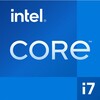AMD Ryzen 9 6900HX vs Intel Core i7-12800H vs AMD Ryzen 9 PRO 6950H
AMD Ryzen 9 6900HX
► remove from comparison
The AMD Ryzen 9 6900HX is a processor for big (gaming) laptops based on the Rembrandt generation. The R9 6900HX integrates all eight cores based on the Zen 3+ microarchitecture. They are clocked at 3.3 (guaranteed base clock) to 4.9 GHz (Turbo) and support SMT / Hyperthreading (16 threads). The chip is manufactured on the modern 6 nm TSMC process. The "X" in the name indicates the overclocking capabilities of the CPU.
The new Zen 3+ is a refresh of the Zen 3 architecture and should not offer a lot of changes. The chip itself however, offers a lot of new features, like support for USB 4 (40 Gbps), PCI-E Gen 4, DDR5-4800MT/s or LPDDR5-6400MT/s, WiFi 6E, Bluetooth LE 5.2, DisplayPort 2, and AV1 decode.
A big novelty is the integrated GPU Radeon 680M, that is now based on the RDNA2 architecture and offers 12 CUs at up to 2.4 GHz. It should be the fastest iGPU of all at the time of announcement.
Performance
The average 6900HX in our database edges out the Core i7-12800H just slightly while, a little disappointingly, not quite managing to leave the 6900HS behind in the dust. Don't get us wrong; this is still a brilliant CPU for your demanding apps and games, as of late 2022. It does lag behind some of the 12th generation Intel Core i9 options, though.
Thanks to its decent cooling solution and a long-term CPU power limit of nearly 90 W, the XMG Neo 15 2022 is among the fastest laptops built around the 6900HX that we know of. It can be at least 20% faster in CPU-bound workloads than the slowest system featuring the same chip in our database, as of August 2023.
Power consumption
This Ryzen 9 series chip has a default TDP, also known as the long-term power limit, of 45 W with the letter "X" indicating that the user is officially allowed to overclock the thing - leading to an increase in power consumption levels. Either way, a high-performance cooling solution is a must for a CPU like this.
The R9 6900HX is built with TSMC's 6 nm process making for very good, as of early 2023, energy efficiency.
Intel Core i7-12800H
► remove from comparison
The Intel Core i7-12800H is a high-end mobile CPU for laptops based on the Alder Lake architecture. It was announced in early 2022 and offers 6 performance cores (P-cores, Golden Cove architecture) and 8 efficient cores (E-cores, Gracemont architecture). The P-cores support Hyper-Threading leading to 20 supported threads when combined with the E-cores. The clock rate ranges from 2.4 to 4.8 GHz on the performance cluster and 1.8 to3.7 GHz on the efficient cluster. The performance of the E-cores should be similar to old Skylake cores (compare to the Core i7-6920HQ). All cores can use up to 24 MB L3 cache. Compared to the 12900H, the 12800H is lower clocked and also features the full "Enterprise" set of vPro features (for remote management).
Features
The integrated memory controller supports various memory types up to DDR5-4800, DDR4-3200, LPDDR5-5200, and LPDDR4x-4267. The Thread Director (in hardware) can support the operating system to decide which thread to use on the performance or efficient cores for the best performance. For AI tasks, the CPU also integrates GNA 3.0 and DL Boost (via AVX2). Quick Sync in version 8 is the same as in the Rocket Lake CPUs and supports MPEG-2, AVC, VC-1 decode, JPEG, VP8 decode, VP9, HEVC, and AV1 decode in hardware. The CPU only supports PCIe 4.0 (x8 for a GPU and two x4 for SSDs).
The integrated graphics adapter is based on the Xe-architecture and offers 96 EUs (Execution Units) operating at up to 1.4 GHz.
Performance
The average 12800H in our database matches the Ryzen 9 6900HS and the Core i9-11900H in multi-thread performance. Which is fairly impressive, as of mid 2022.
Thanks to its decent cooling solution and a long-term CPU power limit of 70 W, the ZBook Studio 16 G9 is among the fastest laptops built around the 12800H that we know of. It can be about 70% faster in CPU-bound workloads than the slowest system featuring the same chip in our database, as of August 2023.
Power consumption
This Core i7 series chip has a "minimum assured" power consumption of 35 W, with 45 W being its Base power consumption. The maximum Intel-recommended Turbo power consumption sits at 115 W.
The i7-12800H is built with Intel's fourth-gen 10 nm process marketed as Intel 7 for average, as of early 2023, energy efficiency.
AMD Ryzen 9 PRO 6950H
► remove from comparison
The AMD Ryzen 9 PRO 6950H is a processor for big (workstation) laptops based on the Rembrandt generation. The R9 6900HX integrates all eight cores based on the Zen 3+ microarchitecture. They are clocked at 3.3 (guaranteed base clock) to 4.9 GHz (Turbo) and support SMT / Hyperthreading (16 threads). The chip is manufactured on the modern 6 nm TSMC process. The 6950H is the professional version of the consumer R9 6900HX without overclocking features but with additional management features and the Microsoft Pluton Security processor.
The new Zen 3+ architecture is a refresh of the Zen 3 architecture and should not offer a lot of changes. The chip itself however, offers a lot of new features, like support for USB 4 (40 Gbps), PCI-E Gen 4, DDR5-4800MT/s or LPDDR5-6400MT/s, WiFi 6E, Bluetooth LE 5.2, DisplayPort 2, and AV1 decode.
A big novelty is the integrated GPU Radeon 680M, that is now based on the RDNA2 architecture and offers 12 CUs at up to 2.4 GHz. It should be the fastest iGPU of all at the time of announcement.
Performance
While we have not tested a single system built around the 6950H as of August 2023, we have tested one system featuring the 6950HS, its slightly more power-efficient brother. Based on that, expect the 6950H to be slightly faster than the Ryzen 7 5800H, Ryzen 9 4900H, Ryzen 5 PRO 7640HS and also the Core i7-11800H. In other words, this is a higher-end chip that will handle almost any task with ease, as of late 2022.
Your mileage may vary depending on how competent the cooling solution of your laptop is and how high the CPU power limits are.
Power consumption
This Ryzen has a default TDP of 45 W (also known as the PL1). A high-performance cooling solution is a must for a CPU like this one here.
Ryzen 9 PRO 6950H is built with TSMC's 6 nm process leading to great, as of late 2022, energy efficiency.
| Model | AMD Ryzen 9 6900HX | Intel Core i7-12800H | AMD Ryzen 9 PRO 6950H | ||||||||||||||||||||||||||||||||||||||||||||||||||||||||||||||||||||||||||||||||||||
| Codename | Rembrandt-H (Zen 3+) | Alder Lake-H | Rembrandt-H (Zen 3+) | ||||||||||||||||||||||||||||||||||||||||||||||||||||||||||||||||||||||||||||||||||||
| Series | AMD Rembrandt (Zen 3+) | Intel Alder Lake-P | AMD Rembrandt (Zen 3+) | ||||||||||||||||||||||||||||||||||||||||||||||||||||||||||||||||||||||||||||||||||||
| Series: Rembrandt (Zen 3+) Rembrandt-H (Zen 3+) |
|
|
| ||||||||||||||||||||||||||||||||||||||||||||||||||||||||||||||||||||||||||||||||||||
| Clock | 3300 - 4900 MHz | 1800 - 4800 MHz | 3300 - 4900 MHz | ||||||||||||||||||||||||||||||||||||||||||||||||||||||||||||||||||||||||||||||||||||
| L1 Cache | 512 KB | 1.2 MB | |||||||||||||||||||||||||||||||||||||||||||||||||||||||||||||||||||||||||||||||||||||
| L2 Cache | 4 MB | 11.5 MB | 4 MB | ||||||||||||||||||||||||||||||||||||||||||||||||||||||||||||||||||||||||||||||||||||
| L3 Cache | 16 MB | 24 MB | 16 MB | ||||||||||||||||||||||||||||||||||||||||||||||||||||||||||||||||||||||||||||||||||||
| Cores / Threads | 8 / 16 | 14 / 20 | 8 / 16 | ||||||||||||||||||||||||||||||||||||||||||||||||||||||||||||||||||||||||||||||||||||
| TDP | 45 Watt | 45 Watt | 45 Watt | ||||||||||||||||||||||||||||||||||||||||||||||||||||||||||||||||||||||||||||||||||||
| Technology | 6 nm | 10 nm | 6 nm | ||||||||||||||||||||||||||||||||||||||||||||||||||||||||||||||||||||||||||||||||||||
| max. Temp. | 95 °C | 100 °C | 95 °C | ||||||||||||||||||||||||||||||||||||||||||||||||||||||||||||||||||||||||||||||||||||
| Socket | FP7/FP7r2 | BGA1744 | FP7/FP7r2 | ||||||||||||||||||||||||||||||||||||||||||||||||||||||||||||||||||||||||||||||||||||
| Features | DDR5-4800/LPDDR5-6400 RAM (incl. ECC), PCIe 4, MMX (+), SSE, SSE2, SSE3, SSSE3, SSE4.1, SSE4.2, SSE4A, AES, AVX, AVX2, FMA3, SHA | DDR4-3200/LPDDR4x-4266/DDR5-4800/LPDDR5-5200 RAM, PCIe 4, Thread Director, DL Boost, GNA, Remote Platform Erase, MMX, SSE, SSE2, SSE3, SSSE3, SSE4.1, SSE4.2, AES, AVX, AVX2, FMA3, SHA | DDR5-4800/LPDDR5-6400 RAM (incl. ECC), PCIe 4, PRO, MMX, SSE, SSE2, SSE3, SSSE3, SSE4A, SSE4.1, SSE4.2, AVX, AVX2, BMI2, ABM, FMA, ADX, SMEP, SMAP, SMT, CPB, AES-NI, RDRAND, RDSEED, SHA, SME | ||||||||||||||||||||||||||||||||||||||||||||||||||||||||||||||||||||||||||||||||||||
| iGPU | AMD Radeon 680M ( - 2400 MHz) | Intel Iris Xe Graphics G7 96EUs ( - 1400 MHz) | AMD Radeon 680M ( - 2400 MHz) | ||||||||||||||||||||||||||||||||||||||||||||||||||||||||||||||||||||||||||||||||||||
| Architecture | x86 | x86 | x86 | ||||||||||||||||||||||||||||||||||||||||||||||||||||||||||||||||||||||||||||||||||||
| Announced | |||||||||||||||||||||||||||||||||||||||||||||||||||||||||||||||||||||||||||||||||||||||
| Manufacturer | www.amd.com | ark.intel.com | www.amd.com |
Benchmarks
Average Benchmarks AMD Ryzen 9 6900HX → 100% n=24
Average Benchmarks Intel Core i7-12800H → 111% n=24
Average Benchmarks AMD Ryzen 9 PRO 6950H → 100% n=24
* Smaller numbers mean a higher performance
1 This benchmark is not used for the average calculation













